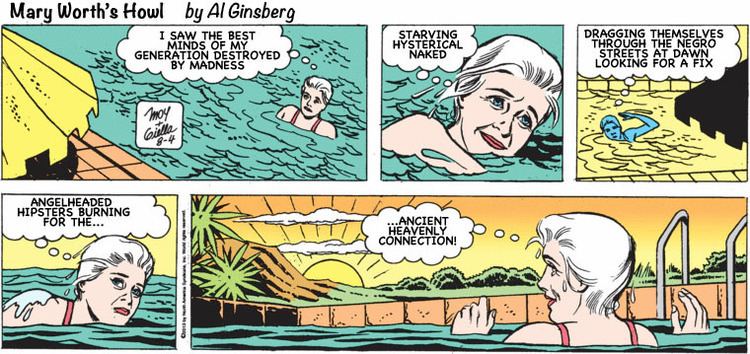 | ||
Similar Rex Morgan - MD, Judge Parker, Mark Trail, Funky Winkerbean, Apartment 3‑G | ||
A2 media mary worth comic strip
Mary Worth is a newspaper comic strip, which has had a seven-decade run since it began in 1938 under the title Mary Worth's Family—a name that was later changed in 1942 in recognition of the fact that the strip came to focus more and more on the title character Mary Worth and less on the members of her extended family. Distributed by King Features Syndicate, this pioneering soap opera-style strip had an influence on several realistically drawn continuity strips that followed. The strip, by Allen Saunders and Dale Connor, initially appeared under the pseudonym "Dale Allen". Ken Ernst succeeded Connor as artist in 1942, and the title was shortened. Harvey Comics published a comic-book spinoff, Love Stories of Mary Worth, from 1949 to 1950. It is loosely associated with an older comic strip, Apple Mary: Mary Worth's Family, though its current syndicate denies any association no matter how loose.
Contents
- A2 media mary worth comic strip
- Mary worth the full version
- Origins
- Characters and story
- End of Ernst era
- Parodies
- References
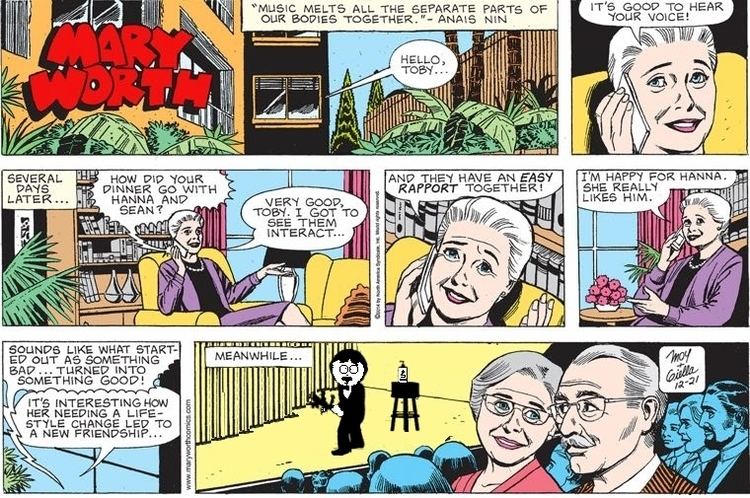
Mary worth the full version
Origins
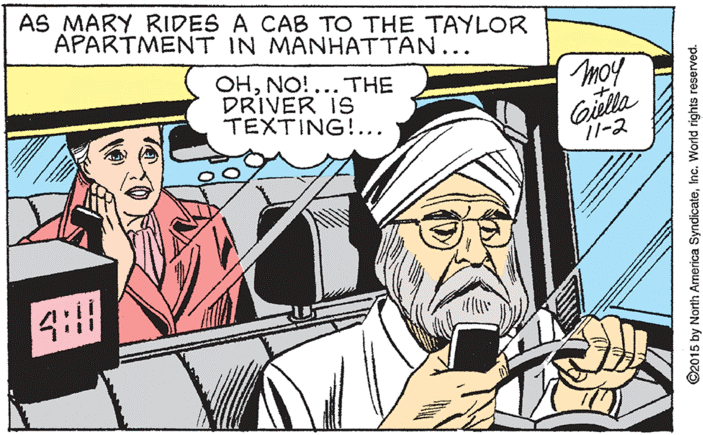
Many reference sources state it was a continuation of King Features Syndicate's Depression-era strip Apple Mary, created by Martha Orr in 1932, centering on an old woman who sold apples on the street and offered humble common sense. Apple Mary ran through 1939, at which point, writes comics historian Don Markstein, "It's generally thought that under a new writer (Allen Saunders, whose credits include Kerry Drake and Steve Roper) and artist (Dale Connor, formerly Orr's assistant), it gradually metamorphosed into Mary Worth. As late as February 1940, the strip appeared as Apple Mary, subtitled Mary Worth's Family. (See example here.)
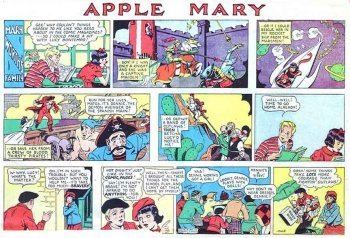
King Features, which gives the debut year of Mary Worth as 1938, denies any connection between the strips, saying, "Contrary to popular belief, Mary Worth is not a continuation of the Depression Era favorite Apple Mary. The strip was created as a replacement feature offered to newspapers when Martha Orr, who created the dowdy apple peddler, retired. The only thing the new title character had in common with her predecessor was a first name."
Saunders himself recalled that Apple Mary became Mary Worth:
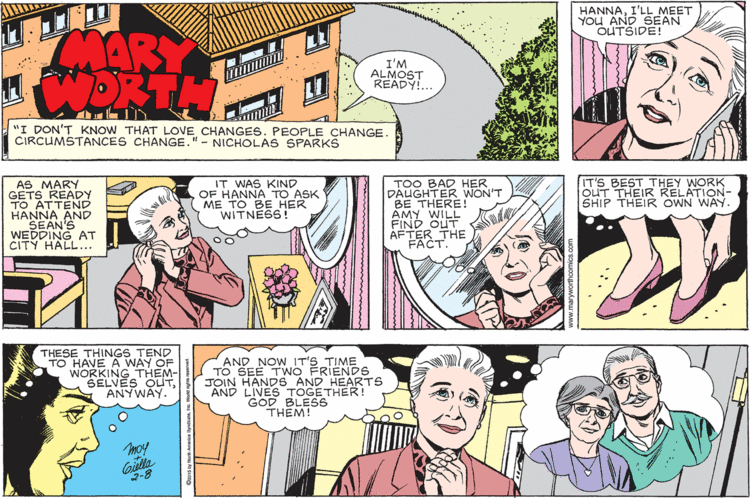
Soon after our team took over, we changed the name of the strip to Mary Worth’s Family. Later, it took on its present title, Mary Worth. In her new role, the old street merchant obviously was not usable. So Ken Ernst gave her a beauty treatment, some weight loss and a more appropriate wardrobe.... We put her applecart in storage, where it will remain, even in the event of another economic slump.
Characters and story
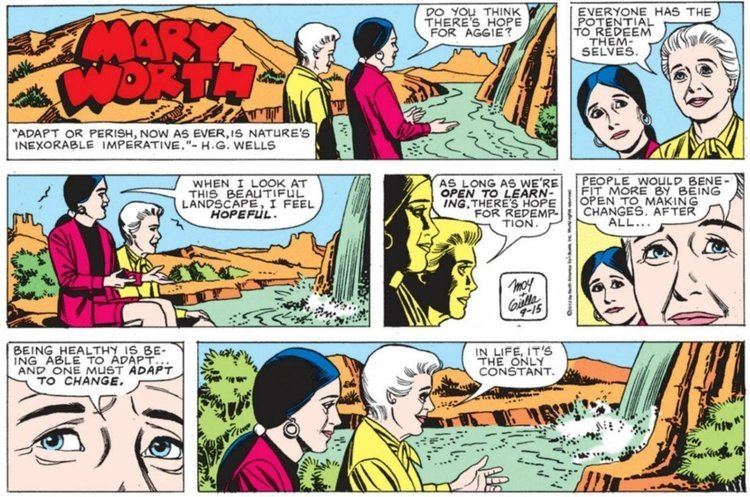
As scripted by Saunders, each story (and its cast) was independent, with little continuity to the next, and Mary generally made only brief appearances to react and give her matronly advice. A former teacher and widow of Wall Street tycoon Jack Worth, Mary formerly lived in New York and later moved to the Charterstone Condominium Complex in fictional Santa Royale, California. Mary serves as an observer of and adviser to her fellow residents, tackling issues such as drug and alcohol abuse, infidelity and teen pregnancy. After Saunders retired, the strip centered more on the title character, along with a regular cast of her closest friends, most of whom were introduced to the strip after 1980: Professor Ian Cameron and his younger wife Toby, advice columnist Wilbur Weston and his college-student daughter Dawn, and Dr. Jeff Cory, Mary's perennial beau, and his son, Dr. Drew Cory.
End of Ernst era
Saunders retired in 1979 (and died in 1986), and Ernst died in 1985. Bill Ziegler, who did backgrounds on the strip for many years, took over the strip after Ernst's death, continuing from 1986 to 1990. Other artists and writers who worked on the strip include Saunders' son, John Saunders (1974–2003), and Ernst's son-in-law, Jim Armstrong (1991). Former DC Comics artist Joe Giella took over the art in 1991 with Karen Moy writing the strip as of the death of John Saunders in 2003.
Giella said in 2010:
When I first took over, the editor asked if I could take a few wrinkles off her face because the previous artist was making her look a little too old. So take a line off here, a line there, you're knocking off about 15, 20 years. She doesn't have the bun, she has a love life, she's going out with a doctor, so I had to streamline her and take a little weight off. The L.A. Times ran a story with the headline [asking if Mary Worth had had a facelift]."
Under Allen Saunders, the daily strips usually had four panels with multiple exchanges among the characters and several stories per year. Under his son, the norm became two panels, with less dialog and stories stretching as long as 18 months. Moy has sought to reverse that "glacial" pace and to show Worth as not only a "figure of common sense and compassion" but also as "human" in her own flaws and experiencing "jealousy, self-doubt, fear, and anger".
Moy's handling of the strip during a 2006 plot line in which Mary was stalked by Aldo Kelrast (an anagram of "stalker"), a man rumored to have killed his late wife, drew media attention because of a character for which the artwork resembled Captain Kangaroo. An intervention staged by Mary and her friends drove Aldo to returning to finding comfort in alcohol, which led to his death in a drunk driving accident, in which he drove off a cliff. A subsequent plot development was the arrival of Ella Byrd, another elderly dispenser of advice, who not only aroused feelings of jealousy and inadequacy in Mary, but also, as a psychic, alerted her to Dr. Jeff being in danger.
Later story lines introduced an additional foil, the alcoholic hospital administrator Jill whose anti-marriage diatribes (caused by her being jilted at the altar by her fiance) put her into Mary's orbit when she offers to help Jeff's sister plan her wedding. Others include plot lines regarding Internet addiction, Mary's refusal to trade in her beloved PC for an iPad, and a lengthy story line where Mary must confront an old flame, whose meddling with his daughter's love life led to her ex-boyfriend dying months later, alone and unloved.
Parodies
In a run of Li'l Abner Sunday strips in 1957, Al Capp lampooned Mary Worth as "Mary Wart". The title character was depicted as a nosy, interfering busybody, with a caricature of Allen Saunders portraying her put-upon, long-suffering son-in-law. Saunders returned Capp's fire with the introduction of the character "Hal Rapp," a foul-tempered, ill-mannered, and (ironically) inebriated cartoonist (Capp was a teetotaler). Later, the feud was revealed to be a collaborative hoax that Capp and his longtime pal Saunders had cooked up together. The Capp-Saunders "feud" fooled both editors and readers, generating plenty of free publicity for both strips—and Capp and Saunders had a good laugh when all was revealed. A 1988 storyline of The Amazing Spider-Man comic strip had a boy character trying to sell comic strips to J. Jonah Jameson; one strip was called Mary Worse.
An episode of The Simpsons, "Bart Sells His Soul", features Comic Book Guy displaying "a very rare Mary Worth in which she has advised a friend to commit suicide". In another episode, "Lady Bouvier's Lover", he trades a Mary Worth telephone to Bart Simpson for an Itchy and Scratchy animation cel. In the episode "Guess Who's Coming to Criticize Dinner?", the tour of the Springfield Shopper leads them to the comic department which is headed by the author of Mary Worth. The guide asks: "Who reads Mary Worth?", to which the group remains silent, and the guide says: "Let's move on." In the Futurama episode "The Why of Fry", Fry remarks: "There are guys in the background of Mary Worth comics that are more important than me," upon finding out that Leela, his love interest, is about to go on a date with an important mayor's aide. The Family Guy episode "Family Guy Viewer Mail 1" features Chris making a print of a Mary Worth strip on Peter's belly fat and stretching it out, Silly Putty-style, saying: "Look what I can do to Mary Worth's smug sense of self-satisfaction." To which Peter responds: "That's right son, take her down a peg."
In a FoxTrot strip, the characters are discussing how many comic strips that day have jokes based on golf. Jason comments: "I loved Mary Worth's line about sand traps." In another FoxTrot strip, after being bombarded by Jason's suggestions, the newspapers give Mary Worth vampire fangs. In a Pearls Before Swine strip, Rat, on steroids, decides he "will kick Mary Worth's &#$*%!" In a Far Side strip, two characters, both of whom are styled after Mary Worth characters, are seen at the door of a typical Far Side character (with a pet cow and snake), who remarks that they must be looking for "Apartment 3-G or Mary Worth or one of those other serious cartoons". In an Over the Hedge Sunday strip, Verne ends with "Maybe Mary Worth needs a pet turtle" (signifying his frustration with his co-characters' disconnection from reality) after RJ and Hammy discusses rather surrealistically around the life of missing socks, as if the socks were individual life forms on their own.
An issue of The Fabulous Furry Freak Brothers features a Mary Worth strip with a comatose Mary. Fat Freddy's Cat comments that she hasn't been the same since her stroke.
The Comics Curmudgeon, Joshua "Josh" Fruhlinger, frequently lampoons Mary Worth and its many storylines and stylistic conventions in his eponymous blog, the Comics Curmudgeon.
In response to readers of a newspaper in Shreveport, Louisiana, voting to drop Mary Worth, the New Adventures of Queen Victoria strip spent a week in September 2007 with Victoria planning Mary's funeral.
In 1938, The Washington Post syndicated an advice column, "Mary Haworth", a pseudonym and a pun on the strip, using the British "Ha" prefix, as half, as in "worth half".
